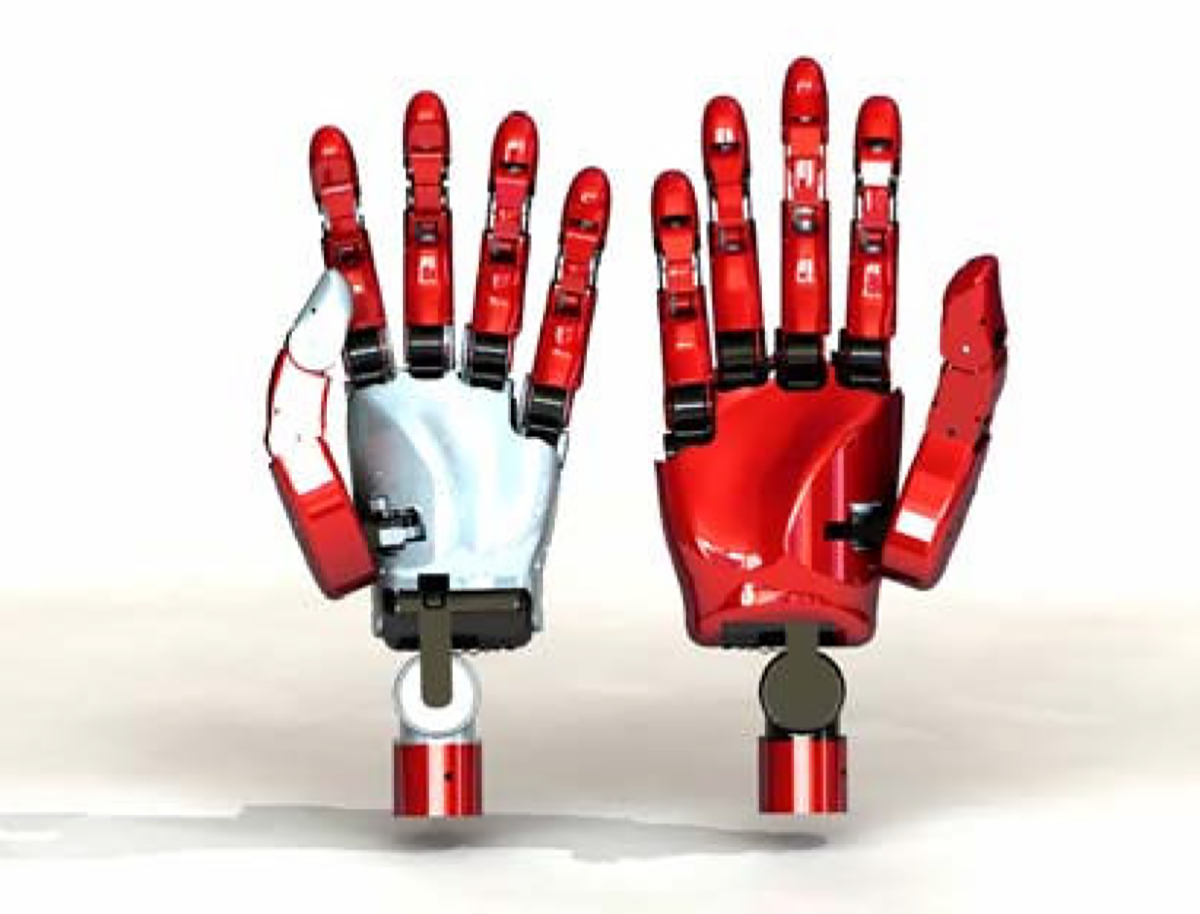Abstract
We are building a new hand with 18 DOF which has all its actuators inside the body of the hand. This hand is in a form suitable for the 50% women but has the strength capabilites of a 50% male.
I. Introduction
Now is an exciting time to be in the field of Upper-Limb Prosthetics. Because of the poor function of current upper-limb prosthetics and the increased incidence of amputation injuries being seen in Operation Enduring Freedom (OEF - Afghanistan) and Operation Iraqi Freedom (OIF) a number of new initiatives have been put into place to develop replacement arm/hand systems capable of replicating the function of the human arm and hand.
In particular the Defense Advanced Research Projects Agency (DARPA), has a 4 year initiative, “Revolutionizing prosthetics 2009”, to develop a replacement arm/hand system capable of enabling soldiers with amputations from OEF/OIF return to service similar to the way those with lower limb amputations have been able to do for years.
The goal of this project, led by the Johns Hopkins University Applied Physics Laboratory has is to design a fully functional biomechatronic analog of the human hand and arm that is capable of duplicating the function of the original limb and that can withstand the rigors of daily living is an extremely challenging and difficult proposition. Our involvement on this team is to develop a fully functional hand suitable for use by persons with transradial amputations.
II. Methods
The design of such an artificial hand is a multifaceted problem involving a large number of disciplines and different areas of expertise – each of which faces their own severe challenges. At the highest level there are fundamental constraints that drive all efforts in all other areas of the system design. These constraints are those of weight, volume, and power. For a hand everything from sensors, to high level processors, low-level control electronics, wires, motors, prosthetic socket, cosmetic covering, and power source must fit into a volume that is broadly anthropomorphic and must weigh no more than ¾ kg total if it is expected to be worn at all.
Our design goal for our hand that it should be usable by individuals with transradial amputations consequently all the actuators necessary to drive 18 degrees-of-freedom (DOF) are intrinsic to (housed in) the body of the hand (some 15 motors in all) with another 3 motors housed in the wrist.
To build this intrinsically actuated hand we are having custom brushless DC electric motors developed capable of providing high torque at physiological hand speeds. These motors are small enough to be fitted into the volume available for a 50% female hand yet capable of providing sufficient torque and speed for a 50% male hand. These motors coupled with high torque capacity Wolfrom transmissions form the drivetrains for each of the DOF’s to be driven in the hand.
Each finger has 3 articulations with 2 motors. The distal and medial phalanges are driven by 1 motor and coupled by a differential drive mechanism. The proximal phalange has it’s own motor. In the palm, the index, ring and little fingers have ab/adduction motors. The thumb has 4 DOFs each with its own motor. The wrist does flexion-extension, radial-ulnar deviation and wrist rotation.
To better withstand shock loads we are exploring the use of inherently compliant DC electric motor drive train architectures, such as series elastic actuators. We believe such drives will enable the hand system have better impact resistance and possibly more biomimetic operation.
Low-level electronics to handle basic motor operation such as commutation and transduction of local sensors are being developed by the Applied Physics Laboratory at Johns Hopkins University. In addition, force or position sensors are being integrated into each finger tip and joint axis. All these sensors and motor controller are coupled to a single large hand control module mounted in the back of the hand.
Control will be by some combination of targeted reinnervation with Implantable myoelectric Sensors and real time pattern recognition and/or peripeheral nerve interface or the hand will be driven in an underactuated fashion.
Fig 1:

Rendered images of the 50% Female and 50% male 18 DOF Intrinsic hands and 3 DOF Intrinsic Wrists
Acknowledgments
This work was supported by the DARPA Revolutionizing Prosthetics 2009 Initiative.
Contributor Information
R. Weir, Rehabilitation Institute of Chicago, Chicago, IL 60611, USA
M. Mitchell, Rehabilitation Institute of Chicago, Chicago, IL 60611, USA
S. Clark, Rehabilitation Institute of Chicago, Chicago, IL 60611, USA
G. Puchhammer, Otto Bock, Vienna, Austria
K. Kelley, Otto Bock, Vienna, Austria
M. Haslinger, Otto Bock, Vienna, Austria
N. Kumar, Otto Bock, Vienna, Austria
R. Hofbauer, Otto Bock, Vienna, Austria
P. Kuschnigg, Otto Bock, Vienna, Austria
V. Cornelius, Otto Bock, Vienna, Austria
M. Eder, Otto Bock, Vienna, Austria
R. Grausenburger, Otto Bock, Vienna, Austria


